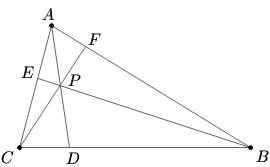Difference between revisions of "Mock AIME 2 2006-2007 Problems/Problem 14"
(→Problem) |
m |
||
| (6 intermediate revisions by 2 users not shown) | |||
| Line 1: | Line 1: | ||
== Problem == | == Problem == | ||
| − | In triangle ABC, <math> | + | In [[triangle]] <math>ABC</math>, <math>AB = 308</math> and <math>AC=35</math>. Given that <math>AD</math>, <math>BE,</math> and <math>CF,</math> [[intersect]] at <math>P</math> and are an [[angle bisector]], [[median of a triangle | median]], and [[altitude]] of the triangle, respectively, compute the [[length]] of <math>BC.</math> |
[[Image:Mock AIME 2 2007 Problem14.jpg]] | [[Image:Mock AIME 2 2007 Problem14.jpg]] | ||
| + | |||
| + | ==Solution== | ||
| + | Let <math>BC = x</math>. | ||
| + | |||
| + | By the [[Angle Bisector Theorem]], <math>\frac{CD}{BD} = \frac{AC}{AB} = \frac{35}{308} = \frac{5}{44}</math>. | ||
| + | |||
| + | Let <math>CF = h</math>. Then by the [[Pythagorean Theorem]], <math>h^2 + AF^2 = 35^2</math> and <math>h^2 + BF^2 = x^2</math>. Subtracting the former [[equation]] from the latter to eliminate <math>h</math>, we have <math>BF^2 - AF^2 = x^2 - 35^2</math> so <math>(BF + AF)(BF - AF) = x^2 - 1225</math>. Since <math>BF + AF = AB = 308</math>, <math>BF - AF = \frac{x^2 - 1225}{308}</math>. We can solve these equations for <math>BF</math> and <math>AF</math> in terms of <math>x</math> to find that <math>BF = 154 + \frac{x^2 - 1225}{616} = </math> and <math>AF = 154 - \frac{x^2 - 1225}{616}</math>. | ||
| + | |||
| + | Now, by [[Ceva's Theorem]], <math>\frac{AE}{EC} \cdot \frac{CD}{DB} \cdot \frac{BF}{FA} = 1</math>, so <math>1 \cdot \frac{5}{44} \cdot \frac{BF}{AF} = 1</math> and <math>5BF = 44AF</math>. Plugging in the values we previously found, | ||
| + | |||
| + | <math>5\cdot 154 + \frac{5(x^2 - 1225)}{616} = 44\cdot 154 - \frac{44(x^2 - 1225)}{616}</math> | ||
| + | |||
| + | so | ||
| + | |||
| + | <math>\frac{49}{616}(x^2 - 1225) = 39\cdot 154</math> | ||
| + | |||
| + | and | ||
| + | |||
| + | <math>x^2 - 1225 = 75504</math> | ||
| + | |||
| + | which yields finally <math>x = 277</math>. | ||
| + | |||
| + | ==See Also== | ||
| + | {{Mock AIME box|year=2006-2007|n=2|num-b=13|num-a=15}} | ||
| + | |||
== Problem Source == | == Problem Source == | ||
| − | 4everwise thought of this problem after reading the first chapter of Geometry Revisited. | + | 4everwise thought of this problem after reading the first chapter of [http://www.amazon.com/exec/obidos/ASIN/0883856190/artofproblems-20 Geometry Revisited]. |
| + | |||
| + | [[Category:Intermediate Geometry Problems]] | ||
Latest revision as of 10:53, 4 April 2012
Contents
Problem
In triangle ![]() ,
, ![]() and
and ![]() . Given that
. Given that ![]() ,
, ![]() and
and ![]() intersect at
intersect at ![]() and are an angle bisector, median, and altitude of the triangle, respectively, compute the length of
and are an angle bisector, median, and altitude of the triangle, respectively, compute the length of ![]()
Solution
Let ![]() .
.
By the Angle Bisector Theorem, ![]() .
.
Let ![]() . Then by the Pythagorean Theorem,
. Then by the Pythagorean Theorem, ![]() and
and ![]() . Subtracting the former equation from the latter to eliminate
. Subtracting the former equation from the latter to eliminate ![]() , we have
, we have ![]() so
so ![]() . Since
. Since ![]() ,
, ![]() . We can solve these equations for
. We can solve these equations for ![]() and
and ![]() in terms of
in terms of ![]() to find that
to find that ![]() and
and ![]() .
.
Now, by Ceva's Theorem, ![]() , so
, so ![]() and
and ![]() . Plugging in the values we previously found,
. Plugging in the values we previously found,
![]()
so
![]()
and
![]()
which yields finally ![]() .
.
See Also
| Mock AIME 2 2006-2007 (Problems, Source) | ||
| Preceded by Problem 13 |
Followed by Problem 15 | |
| 1 • 2 • 3 • 4 • 5 • 6 • 7 • 8 • 9 • 10 • 11 • 12 • 13 • 14 • 15 | ||
Problem Source
4everwise thought of this problem after reading the first chapter of Geometry Revisited.










